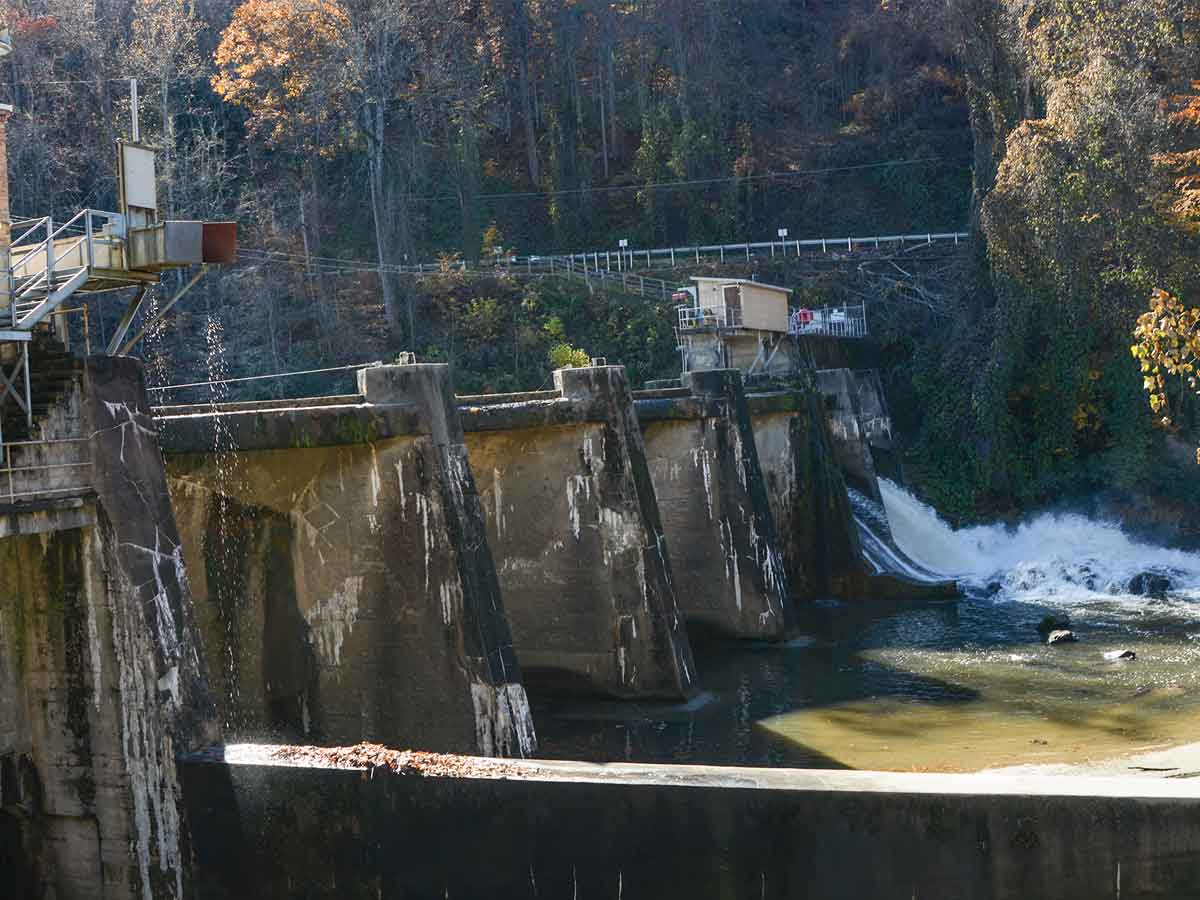Tribe votes no on Ela Dam removal
 Ela Dam was built in 1925 to power the tiny logging town of Bryson City. Holly Kays photo
Ela Dam was built in 1925 to power the tiny logging town of Bryson City. Holly Kays photo
In a narrow vote June 2, the Cherokee Tribal Council voted against a resolution to pursue purchase and removal of the aged Ela Dam — despite a unanimous vote Feb. 3 to have the Eastern Band of Cherokee Indians lead a coalition to work toward dam removal and a unanimous vote from the Timber Committee May 16 to recommend the purchase resolution to Council.
It is unclear why some Tribal Council members opposed the resolution. During the lengthy discussion that preceded the vote, none made definitive statements of dissent, though Secretary of Agriculture and Natural Resources Joey Owle did field a bevy of questions.
Many of those questions dealt with liability and funding issues. Owle assured Council that the tribe would have “essentially zero” liability through the process and that unprecedented funding for dam removal through the federal Infrastructure Investment and Jobs Act, as well as support from the U.S. Fish and Wildlife Service, meant that grant money would cover all the costs of purchase, planning and demolition.
Vice Chairman Albert Rose questioned why the tribe needed to be involved at all, if any of the coalition members interested in the dam’s removal could apply for the federal grant money.
“If they can go after the money, then why do they need us?” he said.
“I would counter with, why shouldn’t it be us leading this?” Owle answered.
Related Items
“They can get the funding, but if they can’t get the funding, then we’re going to be covering the bill,” Rose replied.
Owle told Rose that American Rivers, the partner that would act as project manager on the effort, is not in the business of owning assets and that grant funding for the project was all but assured. Of the coalition members, he said, the tribe was the best positioned to be the property’s final owner. Besides, the purchase would come with 61 acres of riverside property on Cherokee ancestral lands.
“Yes, someone else can do it, but why not have the tribe lead this now?” Owle said. “We are the original inhabitants of this landscape. We are stewards of our resources. The amount of funding and the funding sources that are present, when will we see this in a lifetime?”
Wolfetown Rep. Bo Crowe suggested that the resolution be tabled for a work session, but Owle said that delay would prove fatal to the effort.
“To put it bluntly, if this isn’t passed today, this bill is pretty much dead in the water,” he said.
Ela Dam came into the public eye after a massive sediment release last October blanketed the downstream river, presumably wiping out downstream aquatic communities. Put into operation in 1925, the dam is small, old, and produces very little energy. Its owner, Northbrook Carolina Hydro II, nets only $55,300 annually from running it.
The sediment release spurred a coalition of nonprofits, governments and agencies — as well as Northbrook — to start talking about removing the dam completely.
“When you undam a river, the river can be a river again,” said Erin McCombs, southeastern conservation director for American Rivers. “It can be free-flowing. I like to think about rivers as the lifeblood of the land. We wouldn’t want blockages in our own veins and arteries, so allowing that connectivity and that free-flowingness to return to a river is a real permanent good on the landscape.”
While dams provide a continuous source of energy, they completely change the river ecosystem around them, cutting off the upstream portion from the downstream portion, isolating populations of aquatic species and complicating natural migrations such as fish spawning runs. The evaporation rate from the impoundment behind the dam is much higher than what would naturally occur in a flowing river, and sediment collects there instead of moving through the watershed.
In the months since Council’s unanimous vote to see the tribe lead removal efforts, the coalition has been meeting regularly to discuss the path forward, with Owle keeping Tribal Council members updated. As a result of the sediment dump, Northbrook has received violation notices from multiple agencies and is required to clean up the sediment below the dam. It began that work in December but halted in March for the sicklefin redhorse spawning season. Remediation must resume on June 15, but Northbrook has made clear that it has resources only to complete the cleanup or contribute toward removal efforts — not both.
When Owle brought the purchasing resolution to Timber Committee — composed of Yellowhill Rep. T.W. Saunooke, Painttown Rep. Dike Sneed, Big Cove Rep. Teresa McCoy, Snowbird/Cherokee County Rep. Adam Wachacha, Crowe and Rose — it passed unanimously.
However, some of those same representatives voted against it June 2. In opposition were Crowe, Rose, Chairman Richard French, Yellowhill Rep. David Wolfe and Wolfetown Rep. Bill Taylor. Snowbird/Cherokee County Rep. Bucky Brown, who stepped out minutes before the vote, was counted absent. Due to the weighted system used to calculate Tribal Council votes, this translated to a vote of 44 in favor, 50 opposed and six absent.
The decision was a blow to Owle, McCombs and the rest of the coalition, but it’s not the end of removal efforts. Both Owle and McCombs said that they’re hopeful that another member of the group will agree to purchase the dam prior to the deadline.
“We have an incredibly strong coalition that’s been meeting mostly every other week for the last six months or so,” McCombs said, “and there’s a lot of interest and enthusiasm and passion to see a free Oconaluftee River, and thanks to that strong partnership we’re excited to gather together and see what our options might be.”













